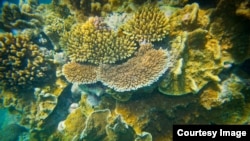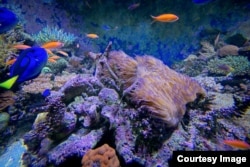VOA reporter Luke Hunt toured the Great Barrier Reef as part of the Australian government's International Media Visits (IMV) program.
In the coming months, the United Nations and the Australian government will square off over whether to list the Great Barrier Reef as endangered.
Environmentalists said the unique marine park is threatened by development and needs stronger safeguards. The Australian government insists it is already a responsible caretaker of the landmark.
Unprecedented storm systems hammered the southern end of the Great Barrier Reef during the first decade of this century.
About 50 percent of coral cover was lost. Scientists said the park - equal in total size to Italy - needs two decades of normal weather for a complete recovery.
Excess nutrients caused by flooding, dredging and harmful farming practices have led to coral bleaching and encouraged the reef's biggest threat, the coral-eating 'crown of thorns' star fish, to breed in uncontrollable numbers.
Australian authorities also have made plans for a major expansion of the nearby Gladstone port to handle increased coal exports, upsetting environmentalists.
In response to the threats, Greenpeace and the World Wildlife Fund (WWF) launched a campaign to have the marine park listed as endangered by UNESCO.
The public outcry that followed prompted the Australian government to initiate The Reef 2050 Long Term Sustainability Plan with a budget of $1.5 billion over the next 10 years.
At stake is a $5 billion-a-year tourism industry, which employs 70,000 people, access to ports handling more than $26 billion in exports, and more importantly the reef itself - home to more than 1,500 species of fish, 500 species of mollusks, 400 species of hard and soft coral, and 250 species of birds.
The Australian plan aims to dramatically improve water quality, cutting the release of inorganic nitrogen from farmers by 80 percent by 2025. It also calls for reviving natural wetlands, reducing the dredging of shipping lanes and banning the dumping of dredging spoil within the park.
State Environment Minister for Queensland, Steven Miles, said the government's plan has support from people across the political spectrum, including indigenous groups , farmers, scientists and port authorities.
“When I first sat down with WWF and said 'what is it we need to do to save the reef?' And they said 'of course in the long term we have to look at climate change but frankly if we don't address dumping and water quality first the climate change affect will come to nothing',” said Miles.
Climate change is a key suspect in the degradation of the reef, with temperatures projected to rise by two to four degrees Celsius by 2050. But Chairman of the Great Barrier Reef Marine Park Authority Russell Reichelt said arguments about rising temperatures should be kept as a separate issue.
“The biggest concerns for the reef, in the long run, are climate change and the risks of rising temperatures affecting corals, the ocean's getting more acidic and affecting the growth of the corals and lowering their resilience - that's number one. Number two is the runoff from the land, the fertilizers, pesticides, the excess erosion after 150 years of agriculture,” said Reichelt.
The Queensland state government has matched a federal government pledge for an additional $75 million to be spent over five years fighting pollution on the reef while enlisting the help of local aboriginal communities.
Of the one million people who live along the Great Barrier Reef coastline there are 20,000 indigenous people, from 72 tribes, whose ancestors have lived off the reef for 8,000 years.
Duane Fraser, a senior figure among them, noted there were more tribal elders involved with the talks than there were members in the Australian parliament.
“For traditional owners and the reef it is immensely important that our position in managing our traditional countries is identified and protected and that we continue to have a place in this landscape to not only contribute but lead the co-management of our traditional estates,” he said.
The northern half of the reef remains in pristine condition and WWF gave qualified support for the plan and its focus on the southern end, but the conservation organization said funding fell short of its expectations given the reef is expected to generate $25 billion for the Australian economy over the next five years.
Greenpeace said the plan does not go far enough and still allows for expanding the commercial port and allowing more coal mining.
The World Heritage Committee, consisting of 21 countries and chaired by Germany, is due to make a preliminary decision on the status of the reef next month before a final conference is held in Bonn in June.












